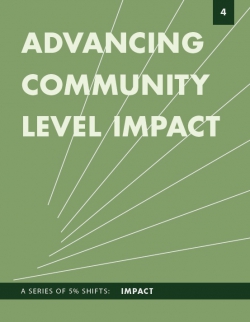Advancing Community Level Impact: A Series of 5% Shifts
Service providers are on the front lines of our nation’s struggles with the effects of poverty and inequity. While the sector has always focused on helping people, service organizations underwent significant changes in the 1980s when government began to contract out service delivery on an unprecedented scale. Over time, organizations absorbed the service functions that were largely abandoned by the state – meeting people’s basic needs for food, shelter, health, and safety. Facing increased competition for government contracts, increasing demands for services and tougher measures of accountability, many of these organizations adapted to the trends by becoming business savvy, professionalizing staff, and looking for models of efficiency. Other organizations did not participate in the new government contracting system and instead focused on organizing and advocating for changes in the government’s social welfare policies. These major shifts in the sector are often described as creating a divide between “providing services to oppressed populations or organizing them to challenge power structures.” But in practice, service groups fall at various places along a spectrum, and increasingly service organizations are integrating their mission to meet individual needs with their aspiration to address the larger systems, policies, and structures that contribute to the problems people face. This report examines how two organizations developed and executed strategies that advanced their commitment to bridge the service-organizing “divide” by thinking beyond individual needs to address problems at a community level.
The Mutual Assistance Network of Del Paso Heights in Sacramento, CA, went through a series of small shifts in how the organization saw its role in relation to individuals and the community. They rethought the organization’s overarching philosophy and went from focusing on addressing the problems of individual residents to creating opportunities for both individual and community growth. At the Cypress Hills Local Development Corporation in Brooklyn, NY, the organization had already made a strategic commitment to resident engagement and leadership development, but was challenged to make this strategy real throughout the entire staff team. They therefore revised job descriptions and staff evaluations to reflect the organization’s social change priorities, and integrate its commitment to social change in all its staffing decisions.
Shifting an organization from focusing on helping individuals address their personal challenges towards impacting neighborhoods as a whole may start as small shifts, but over time will result in bigger changes. As the authors of the report “Resident-Centered Community Building: What Makes it Different?” note, “creating healthy and vibrant communities is a long-term process” so it is important for organizations to see the shifts they make as the building blocks of the foundation for long-term work. As the social safety net continues to be threatened by federal, state, and local budget cuts, nonprofit agencies face an ever-growing number of problems to be solved. Now is the time for providers to think about how to make small shifts in how they view their work with individuals and communities, involve and honor the voice and leadership of program participants, and adapt their internal management so that they can have far-reaching impacts in their communities.
© 2013

